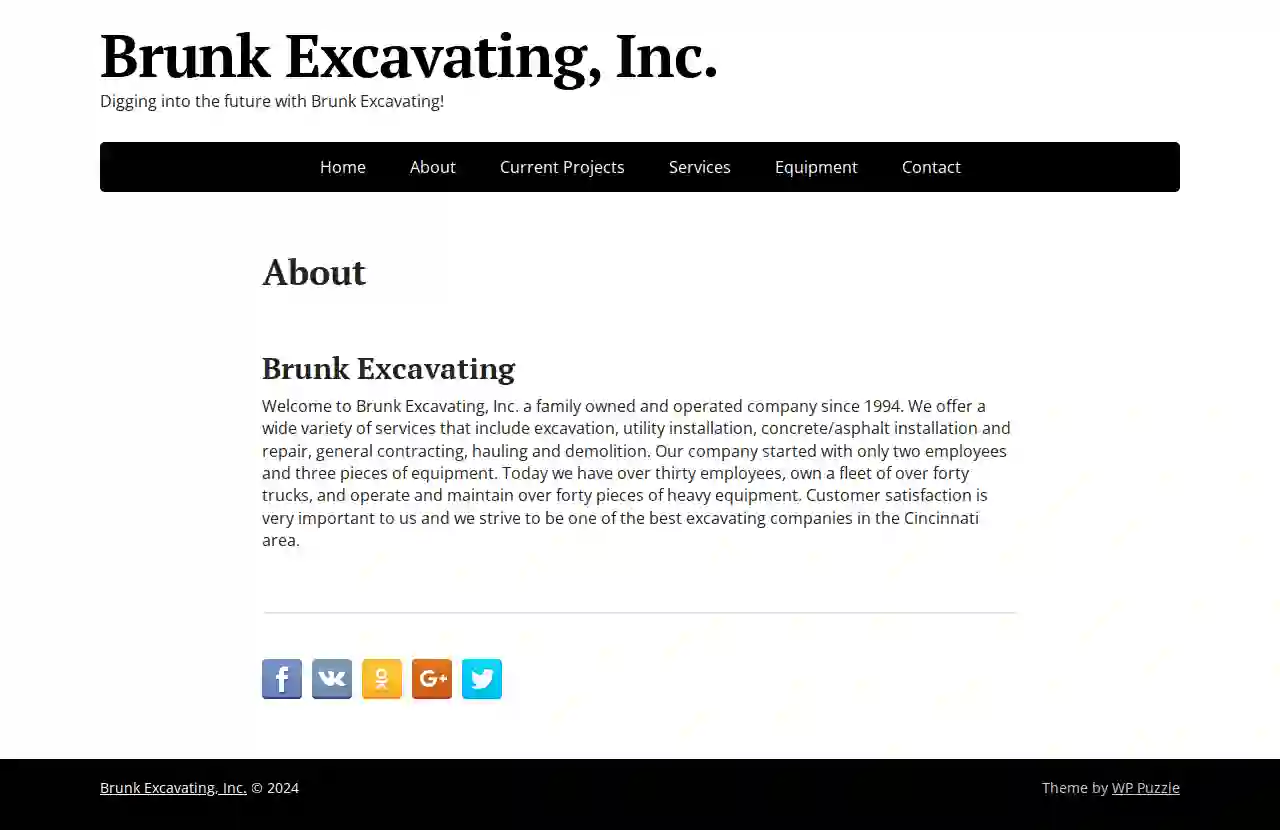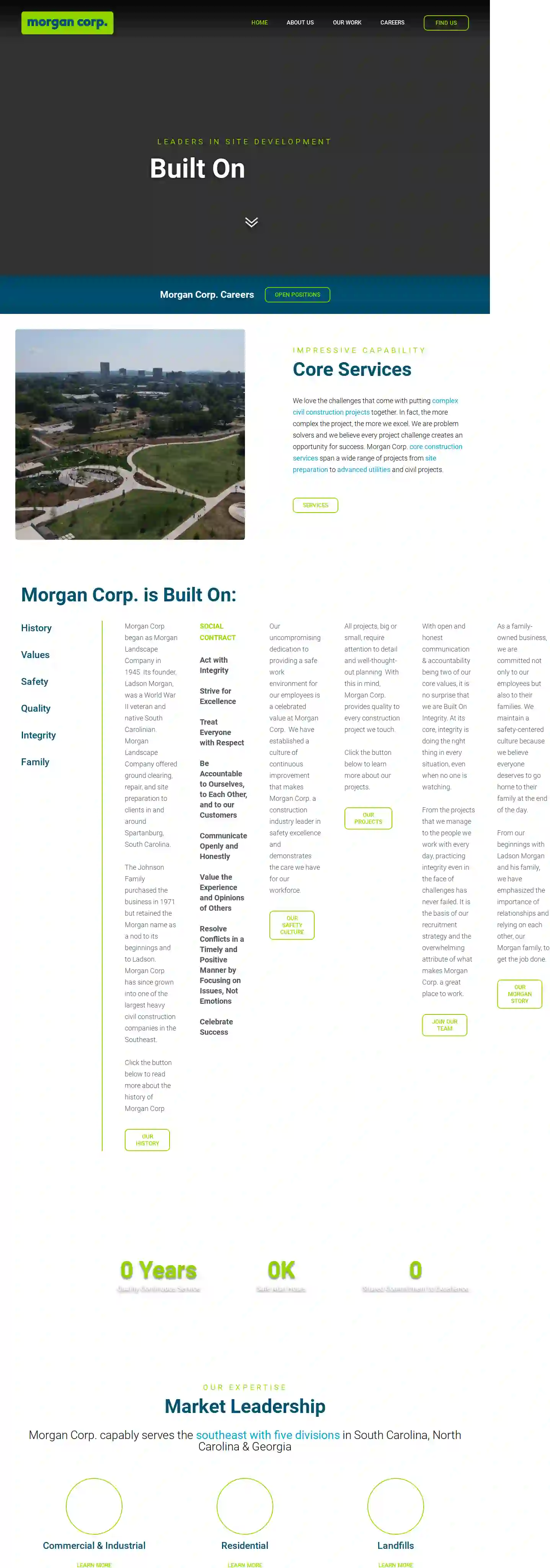Excavation Contractors Athens
Find Excavation Companies in Athens
Get multiple Excavation Services quotes for your project today! Compare profiles, reviews, accreditations, portfolio, etc... and choose the best deal.
- C
C W Earthworks
52 reviewsSavannah, USFacebook is a social networking service and website launched in February 2004, owned by Meta Platforms. It is the largest social network in the world, with over 2.91 billion monthly active users as of the first quarter of 2023. Users can create a personal profile, add other users as friends, and exchange messages, photos, and videos. Facebook is also used by businesses to connect with customers and promote their products and services.
- Services
- Why Us?
- Gallery
Get Quote 
KWS Excavation & Grading Services
578 reviewsAtlanta, USUnearth Your Dreams From excavation to site preparation, KWS Excavation & Grading Services is here to make your vision a reality. Expert Excavation & Grading Services KWS Excavation & Grading Services is a veteran-owned business providing high-quality excavation, grading, and land clearing services to homeowners and commercial clients in the state of Georgia. Our team is certified in erosion and sediment control, ensuring your project is completed with attention to detail and environmental compliance. From new house pads and crawl spaces to any size demolitions, trenches, and more! Within any project, we ensure our process protects the environment! We offer a wide range of services to meet your specific needs. Uncovering the Possibilities: A Photo Gallery of KWS Find out why our customers love us! Meet Your Reliable Excavation Experts Welcome to KWS Excavation & Grading Services, with 10 years of experience we provide top-notch earth moving services for all your construction needs. Our team of skilled professionals is equipped to handle any project, big or small. From site preparation to demolitions, we've got you covered.
- Services
- Why Us?
- Our Team
- Gallery
Get Quote
Thomas Bowlin Land Services
4.58 reviewsMacon, USReclaim Your Property! Thomas Bowlin Land Services is a trusted and reliable company serving Middle and South Georgia. We specialize in a wide range of residential and commercial services, including: Complete Concrete Grading/Landscaping Land Clearing Drainage Systems Underbrush Clearing Gravel + Rock Work Tree + Brush Cleanup Demolition Our team is dedicated to providing high-quality workmanship and exceptional customer service. We are committed to exceeding your expectations and delivering results that you can be proud of. Contact us today for a free estimate!
- Services
- Why Us?
- Testimonials
- Gallery
Get Quote
Brunk Excavating Inc
2.917 reviewsColumbus, USWelcome to Brunk Excavating, Inc., a family owned and operated company since 1994. We offer a wide variety of services that include excavation, utility installation, concrete/asphalt installation and repair, general contracting, hauling and demolition. Our company started with only two employees and three pieces of equipment. Today we have over thirty employees, own a fleet of over forty trucks, and operate and maintain over forty pieces of heavy equipment. Customer satisfaction is very important to us and we strive to be one of the best excavating companies in the Cincinnati area.
- Services
- Why Us?
Get Quote
John Eramo & Sons, Inc.
4.26 reviews3670 Lacon Road, Hilliard, 43026, USYour Central Ohio Site Development Contractor From the initial consultation & estimate, to the final installations, Eramo & Sons handles your project with the utmost care. Comprehensive Excavation & Construction Services to Complete the Job John Eramo & Sons is a 3rd generation, family-owned and operated excavation & site development contractor based in Hilliard, Ohio. With safety, timeliness and complete customer satisfaction at the helm of our operation, we have proudly stood atop the industry in Central Ohio, excelling in earthmoving, underground utility construction, demolition services & a number of other fields. We bring your vision to life, starting from excavation, then off to seamless pavement work & all the way to installation of water lines & asphalt street lights. As a complete site development contractor, we can do it all in one contract. A foundation of Experience & Excellence As a 3rd generation family-owned business, we believe that our employers are an integral part of our organization – our family. Many of our valued employees have more than a decade of construction experience, helping to bring our customers not only quality and experience they deserve but the dependability of longevity that exceeds expectations. Our managment team alone has more than 100+ years of combined field experience. When you’re looking for a site development contractor you can trust, invest your confidence in Eramo & Sons.
- Services
- Why Us?
- Gallery
Get Quote
United Grading & Excavating
319 reviews199-A Fairburn Ind Blvd, Fairburn, 30213, USAbout United Grading & Excavating United Grading & Excavating is a full-service Site Development Contractor, specializing in clearing, grading, and utility work. We have a SAFETY EMR RATE OF 0.71. Our company performs commercial, industrial, multi-family residential, municipal, and governmental site development throughout the Southeast. United Grading and Excavating is committed to providing expert service at a competitive price while completing projects in a timely manner. Our growth is reflected in an ever-expanding list of satisfied customers that appreciate consistency in work, attention to detail, and commitment to a job well done. United Grading & Excavating can perform either as a general contractor working directly for the owner of a project, or as a subcontractor to another general contractor or construction manager. With multiple crews and an extensive fleet of equipment, we can meet the overall schedule of any project. Our management team, with more than 60 years of site work experience, along with our highly motivated and accomplished field personnel, ensures that we will meet our goal to exceed the customers’ expectations by delivering a quality site, safely, on time, and within budget. 1995 Year Established 400+ Projects Completed 250+ Dedicated Employees 1 Path to Success
- Services
- Why Us?
- Gallery
Get Quote
Morgan Corp.
4.817 reviewsCorporate Headquarters, Spartanburg, SC, USMorgan Corp. Careers Open Positions IMPRESSIVE CAPABILITY Core Services We love the challenges that come with putting complex civil construction projects together. In fact, the more complex the project, the more we excel. We are problem solvers and we believe every project challenge creates an opportunity for success. Morgan Corp. core construction services span a wide range of projects from site preparation to advanced utilities and civil projects. SERVICES Morgan Corp. is Built On: History Values Safety Quality Integrity Family History Values Safety Quality Integrity Family Morgan Corp. began as Morgan Landscape Company in 1945. Its founder, Ladson Morgan, was a World War II veteran and native South Carolinian. Morgan Landscape Company offered ground clearing, repair, and site preparation to clients in and around Spartanburg, South Carolina. The Johnson Family purchased the business in 1971 but retained the Morgan name as a nod to its beginnings and to Ladson. Morgan Corp. has since grown into one of the largest heavy civil construction companies in the Southeast. Click the button below to read more about the history of Morgan Corp. SOCIAL CONTRACT Act with Integrity Strive for Excellence Treat Everyone with Respect Be Accountable to Ourselves, to Each Other, and to our Customers Communicate Openly and Honestly Value the Experience and Opinions of Others Resolve Conflicts in a Timely and Positive Manner by Focusing on Issues, Not Emotions Celebrate Success Our uncompromising dedication to providing a safe work environment for our employees is a celebrated value at Morgan Corp. We have established a culture of continuous improvement that makes Morgan Corp. a construction industry leader in safety excellence and demonstrates the care we have for our workforce. Our Safety Culture All projects, big or small, require attention to detail and well-thought-out planning. With this in mind, Morgan Corp. provides quality to every construction project we touch. Click the button below to learn more about our projects. With open and honest communication & accountability being two of our core values, it is no surprise that we are Built On Integrity. At its core, integrity is doing the right thing in every situation, even when no one is watching. From the projects that we manage to the people we work with every day, practicing integrity even in the face of challenges has never failed. It is the basis of our recruitment strategy and the overwhelming attribute of what makes Morgan Corp. a great place to work. Join Our Team As a family-owned business, we are committed not only to our employees but also to their families. We maintain a safety-centered culture because we believe everyone deserves to go home to their family at the end of the day. From our beginnings with Ladson Morgan and his family, we have emphasized the importance of relationships and relying on each other, our Morgan family, to get the job done. Our Morgan Story 0 Years Quality Continuous Service 0K Safe Man Hours 0 Shared Commitment to Excellence OUR EXPERTISE Market Leadership Morgan Corp. capably serves the southeast with five divisions in South Carolina, North Carolina & Georgia Commercial & Industrial Learn More Residential Learn More Landfills Learn More Power & Energy Learn More Roller Compacted Concrete Learn More Dams Learn More ABOUT US All about our people We’ve been leaders in commercial and industrial site development for over 75 years. We employ qualified personnel who pay attention to details and understand the importance of adaptability. We work as a whole to uphold our core values of safety, quality, and productivity. ABOUT US Latest News & Blog VIEW MORE Our People Built On: Classroom to Career Our People Built On: The Next Generation News On the Road Again! Rooster’s Summer Cookout Series Build with Morgan Corp. Find Us Join the Morgan Corp. Family Apply Now
- Services
- Why Us?
- Gallery
Get Quote
J. Harvey Excavating, LLC
59 reviews20890 GA-144, Richmond Hill, 31324, USJ. Harvey Excavating - Your Expert in Mulching & Excavating Don't Start Your Project Without J. Harvey Excavating on Your Job Call Richmond Hill, Savannah, Hinesville & Georgetown, GA's trusted excavating contractors Do you need efficient excavation services? Are you looking for a mulching service? J. Harvey Excavating, LLC is the company to call in Richmond Hill, Georgetown, Hinesville & Savannah, GA for complete land clearing and mowing services. We rely on more than two decades of experience to excavate your property and mulch trees and shrubs.Before you start your construction project, get a free estimate from J. Harvey Excavating by calling 912-294-3272. Don't forget to ask about our discount for military personnel. Our excavating contractors are ready to excavate your land in a flash Have confidence you'll get a clear plot of land to build on with services from J. Harvey Excavating. Turn to our excavating contractor for residential and commercial: Excavation servicesLand grading servicesMulching servicesMowing servicesWe have the experience and equipment needed to complete your job right the first time around. We can mulch trees that are over 20 Georgetown, Hinesville & Savannah, GA area. Honest pricing and first-rate mulching services At J. Harvey Excavating, we're dedicated to being upfront with every customer. We'll go over your job thoroughly to make sure we provide you with the service you need.We're transparent with every customer and never add unnecessary charges to the estimate. Schedule mulching, land clearing or mowing services from J. Harvey Excavating in Richmond Hill, Hinesville, Georgetown, and Savannah, GA today.
- Services
- Why Us?
- Testimonials
- Gallery
Get Quote
Eccard Excavating, LLC
551 reviews5124 Old Millersport Road, Pleasantville, OH 43148, 43148, USCommercial & Residential Septic, Excavation & Utility Specialists Serving Lancaster and the greater Eastern region of Columbus, Oh Extraordinary septic and excavation solutions at Eccard Excavating. From precision digging to expert site preparation, our dedication to excellence ensures that your projects exceed expectations. Welcome to a world where quality meets reliability, right here in Lancaster and the surrounding regions in Fairfield and Licking County, Ohio.
- Services
- Why Us?
- Testimonials
- Gallery
Get Quote
GS Excavation & Hydroseeding
57 reviewsColumbus, USWelcome to GS Excavation and Hydroseeding Welcome to GS Excavation and Hydroseeding. Our main goal is to always achieve a high level of customer satisfaction with the services and products that we provide. We offer both Commercial and Residential Excavation, and HydroSeeding. No project is too big or too small for us. We also offer Commercial Snow and Ice removal. Please browse our site to discover what we’re all about. Call us Email us
- Services
- Why Us?
- Gallery
Get Quote
Over 3,943+ Excavation Pros on our directory
Our excavation pros operate in Athens and beyond!
ExcavationHQ has curated and vetted the Best Excavation Contractors near Athens. Find a top & trustworthy business today.
Frequently Asked Questions About Excavation Contractors
- Clear the Area: Remove any obstacles, including vehicles, outdoor furniture, landscaping features, or structures, from the excavation zone and surrounding area.
- Mark Existing Features: Identify and mark underground utilities, septic tanks, sprinkler systems, or other buried elements you want to protect.
- Protect Landscaping: Use tarps or fencing to shield trees, shrubs, gardens, or other landscaping elements from damage.
- Provide Access: Ensure the excavation contractor has clear access to the work area, including gates wide enough for equipment.
- Discuss Logistics: Coordinate with the contractor regarding parking arrangements, material delivery, and any special instructions or concerns you might have.
- Project Type and Size: Ensure the contractor has experience handling projects similar to yours in scale and complexity.
- Reputation and Reviews: Check online reviews and testimonials, and request references from previous clients.
- Licensing and Insurance: Verify that the contractor is properly licensed and insured to protect you from liability.
- Equipment and Resources: Confirm that they have the necessary equipment and resources for your project's needs.
- Communication and Transparency: Choose a contractor who communicates clearly, provides detailed estimates, and keeps you informed throughout the project.
- Safety Record: Inquire about their safety protocols and track record to ensure a safe work environment.
- Price: While price is important, it shouldn't be the only deciding factor. Balance affordability with experience, reputation, and quality of service.
- Topsoil Removal: Stripping the fertile topsoil layer from a site, often preserving it for landscaping.
- Trench Excavation: Digging long, narrow trenches for utilities (pipes, cables) or foundations.
- Basement Excavation: Removing earth to create a space for a basement beneath a structure.
- Pool Excavation: Digging a precise hole for installing a swimming pool.
- Roadway Excavation: Removing earth and preparing the ground for road construction.
- Demolition Excavation: Clearing debris and preparing the site after demolition.
- Channel Excavation: Creating channels for drainage or irrigation.
- Sloped Property: Your property has a significant slope, making it prone to soil erosion or landslides.
- Creating Usable Space: You want to level off a sloped area to create a flat surface for patios, gardens, or other outdoor spaces.
- Preventing Damage: Erosion is threatening existing structures, driveways, or walkways.
- Landscaping Features: You're incorporating tiered gardens, raised beds, or other landscaping elements requiring soil retention.
How do I prepare my property for excavation?
How do I choose the right excavation contractor for my project?
What are the different types of excavation?
How do I know if I need a retaining wall?
How do I prepare my property for excavation?
- Clear the Area: Remove any obstacles, including vehicles, outdoor furniture, landscaping features, or structures, from the excavation zone and surrounding area.
- Mark Existing Features: Identify and mark underground utilities, septic tanks, sprinkler systems, or other buried elements you want to protect.
- Protect Landscaping: Use tarps or fencing to shield trees, shrubs, gardens, or other landscaping elements from damage.
- Provide Access: Ensure the excavation contractor has clear access to the work area, including gates wide enough for equipment.
- Discuss Logistics: Coordinate with the contractor regarding parking arrangements, material delivery, and any special instructions or concerns you might have.
How do I choose the right excavation contractor for my project?
- Project Type and Size: Ensure the contractor has experience handling projects similar to yours in scale and complexity.
- Reputation and Reviews: Check online reviews and testimonials, and request references from previous clients.
- Licensing and Insurance: Verify that the contractor is properly licensed and insured to protect you from liability.
- Equipment and Resources: Confirm that they have the necessary equipment and resources for your project's needs.
- Communication and Transparency: Choose a contractor who communicates clearly, provides detailed estimates, and keeps you informed throughout the project.
- Safety Record: Inquire about their safety protocols and track record to ensure a safe work environment.
- Price: While price is important, it shouldn't be the only deciding factor. Balance affordability with experience, reputation, and quality of service.
What are the different types of excavation?
- Topsoil Removal: Stripping the fertile topsoil layer from a site, often preserving it for landscaping.
- Trench Excavation: Digging long, narrow trenches for utilities (pipes, cables) or foundations.
- Basement Excavation: Removing earth to create a space for a basement beneath a structure.
- Pool Excavation: Digging a precise hole for installing a swimming pool.
- Roadway Excavation: Removing earth and preparing the ground for road construction.
- Demolition Excavation: Clearing debris and preparing the site after demolition.
- Channel Excavation: Creating channels for drainage or irrigation.
How do I know if I need a retaining wall?
- Sloped Property: Your property has a significant slope, making it prone to soil erosion or landslides.
- Creating Usable Space: You want to level off a sloped area to create a flat surface for patios, gardens, or other outdoor spaces.
- Preventing Damage: Erosion is threatening existing structures, driveways, or walkways.
- Landscaping Features: You're incorporating tiered gardens, raised beds, or other landscaping elements requiring soil retention.